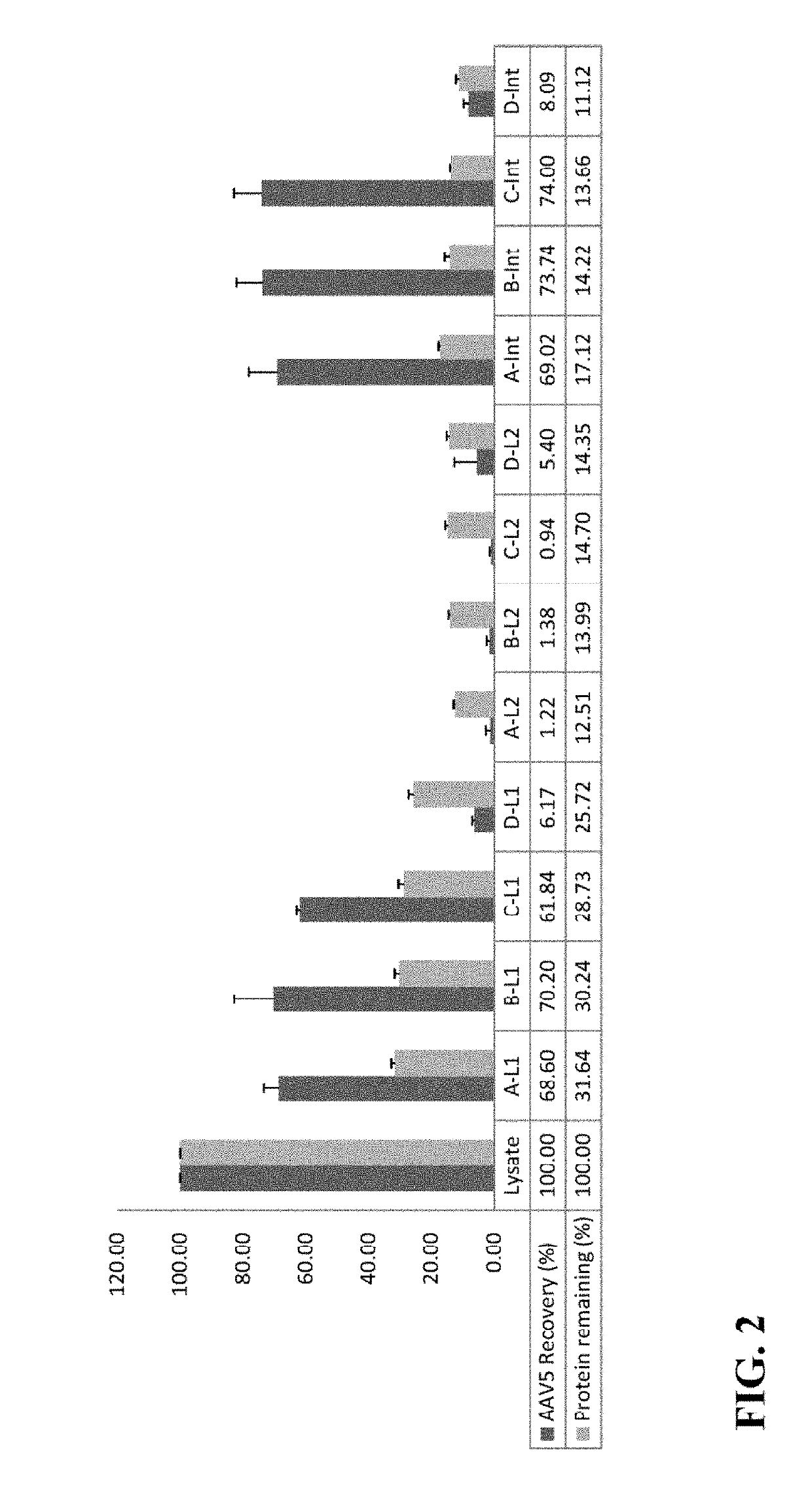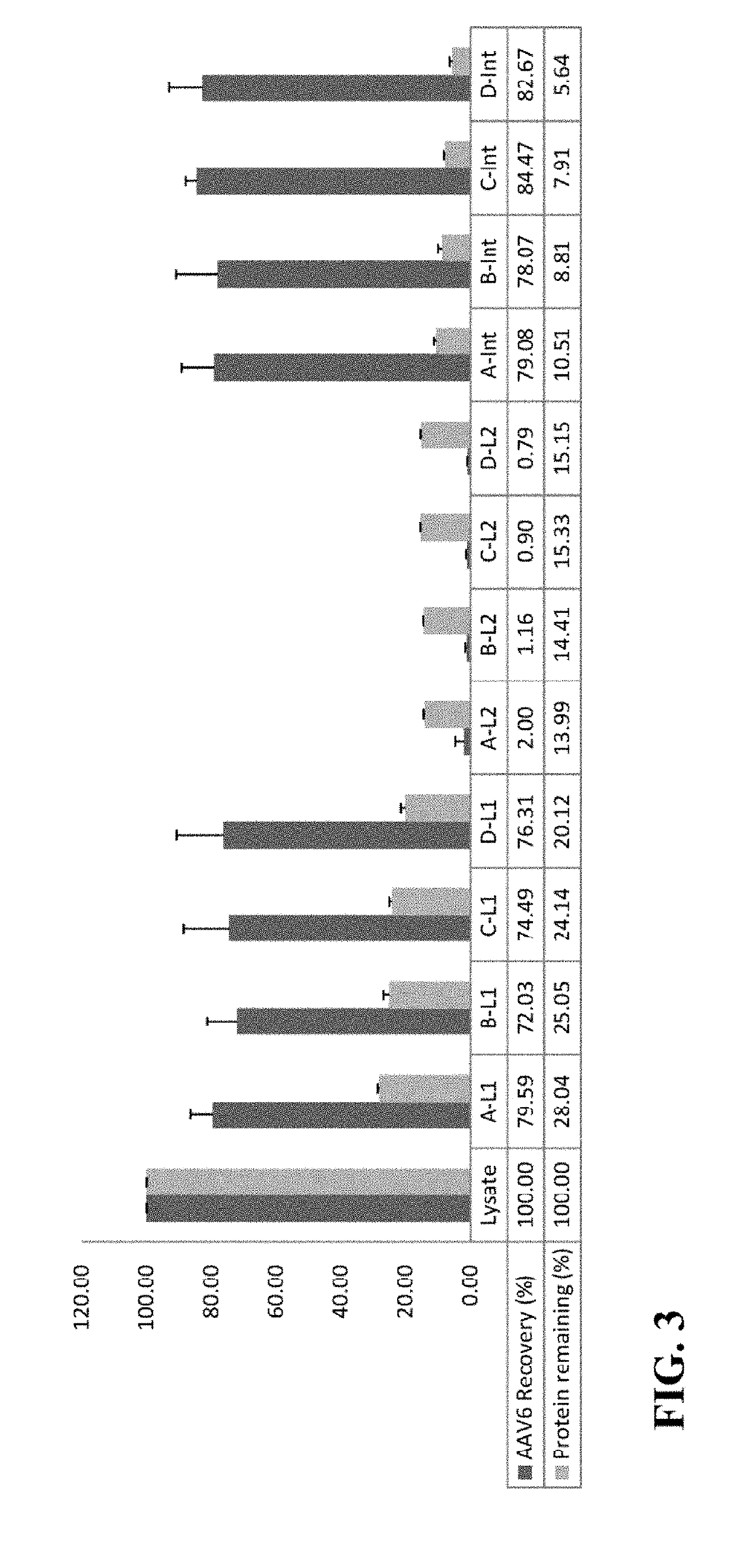Three Phase Partitioning (TPP) Method for Virus Purification
a three-phase, virus technology, applied in the field of virus purification, can solve the problems of difficult scaling up, high cost, and complicated nature of column chromatography for purifying aav,
- Summary
- Abstract
- Description
- Claims
- Application Information
AI Technical Summary
Benefits of technology
Problems solved by technology
Method used
Image
Examples
example 1
[0072]This example illustrates the effects of varying ammonium sulfate saturation levels on AAV2 distribution in the first round of TPP of cell lysates subjected to TPP.
[0073]Initially, it was found that subjecting cell lysates to a first round of TPP resulted in AAV2 particles remaining in the aqueous phase while cellular proteins and cell debris formed a solid interphase. A second round of TPP led to the AAV particles forming a solid interphase, with cellular proteins and cell debris remaining in the aqueous phase. In further experiments, the effects of varying ammonium sulfate saturation values in the first round of TPP on AAV2 distribution on cell lysates subjected to TPP were investigated. The results, displayed in FIG. 1, are representative of averages of lysates from three independent experiments. In FIG. 1, A, B, C, and D correspond to cell lysates from AAV2-infected Sf9 cells with 10%, 15%, 20%, and 25% saturation of ammonium sulfate, respectively in the first round of TPP;...
example 2
[0076]This example illustrates the effects on AAV5 distribution of varying ammonium sulfate saturation levels in the first round of TPP of cell lysates subjected to TPP.
[0077]In these experiments, the effects of varying ammonium sulfate saturation values in the first round of TPP on AAV5 distribution on cell lysates subjected to TPP were investigated. The results, displayed in FIG. 2, are representative of average values from three lysates with 10%, 15%, 20%, and 25% saturation of ammonium sulfate (A, B, C and D, respectively) in the first round of TPP; L1 represents the aqueous phase after the first round of TPP; L2 represents the aqueous phase after the second round of TPP at a fixed 35% saturation of ammonium sulfate; Int represents the interphase after second round of TPP at fixed 35% saturation of ammonium sulfate.
[0078]When cell lysates containing AAV5 vectors were subjected to a first round of TPP with 10%, 15%, 20%, or 25% ammonium sulfate saturation, and a second round of T...
example 3
[0080]This example illustrates the effects on AAV6 distribution of varying ammonium sulfate saturation levels in the first round of TPP of cell lysates subjected to TPP.
[0081]In these experiments, the effects of varying ammonium sulfate saturation levels in the first round of TPP on AAV6 distribution on cell lysates subjected to TPP were investigated. The results, displayed in FIG. 3, are representative of average values from three lysates. A, B, C, and D represent cell lysates with 15%, 20% / a, 25%, and 30% ammonium sulfate saturation levels, respectively in the first round of TPP; L1 represents the aqueous phase after the first round of TPP; L2 represents the aqueous phase after the second round of TPP at a fixed concentration of 35% saturation of ammonium sulfate; Int represents the interphase after the second round of TPP at a fixed concentration of 35% saturation of ammonium sulfate.
[0082]When cell lysates containing AAV6 vectors were subjected to the first round of TPP with 15%...
PUM
| Property | Measurement | Unit |
|---|---|---|
| pH | aaaaa | aaaaa |
| pH | aaaaa | aaaaa |
| pH | aaaaa | aaaaa |
Abstract
Description
Claims
Application Information
 Login to View More
Login to View More - R&D
- Intellectual Property
- Life Sciences
- Materials
- Tech Scout
- Unparalleled Data Quality
- Higher Quality Content
- 60% Fewer Hallucinations
Browse by: Latest US Patents, China's latest patents, Technical Efficacy Thesaurus, Application Domain, Technology Topic, Popular Technical Reports.
© 2025 PatSnap. All rights reserved.Legal|Privacy policy|Modern Slavery Act Transparency Statement|Sitemap|About US| Contact US: help@patsnap.com



